Stories
Coach Allee and His Winners — The Comets
Day Makes Indiana Referee History
New Culver Logo
The Rock, Home of Plymouth Basketball Since 1976
Pride of Argos Still Our Pride
Girls Basketball Run Brings Back Memories for Tiny Argos
How Teddy Roosevelt Helped Save Football
Who won, Tippecanoe or Argos?
Rampaging Russ Retires
Smallish Argos Giant in Semistate
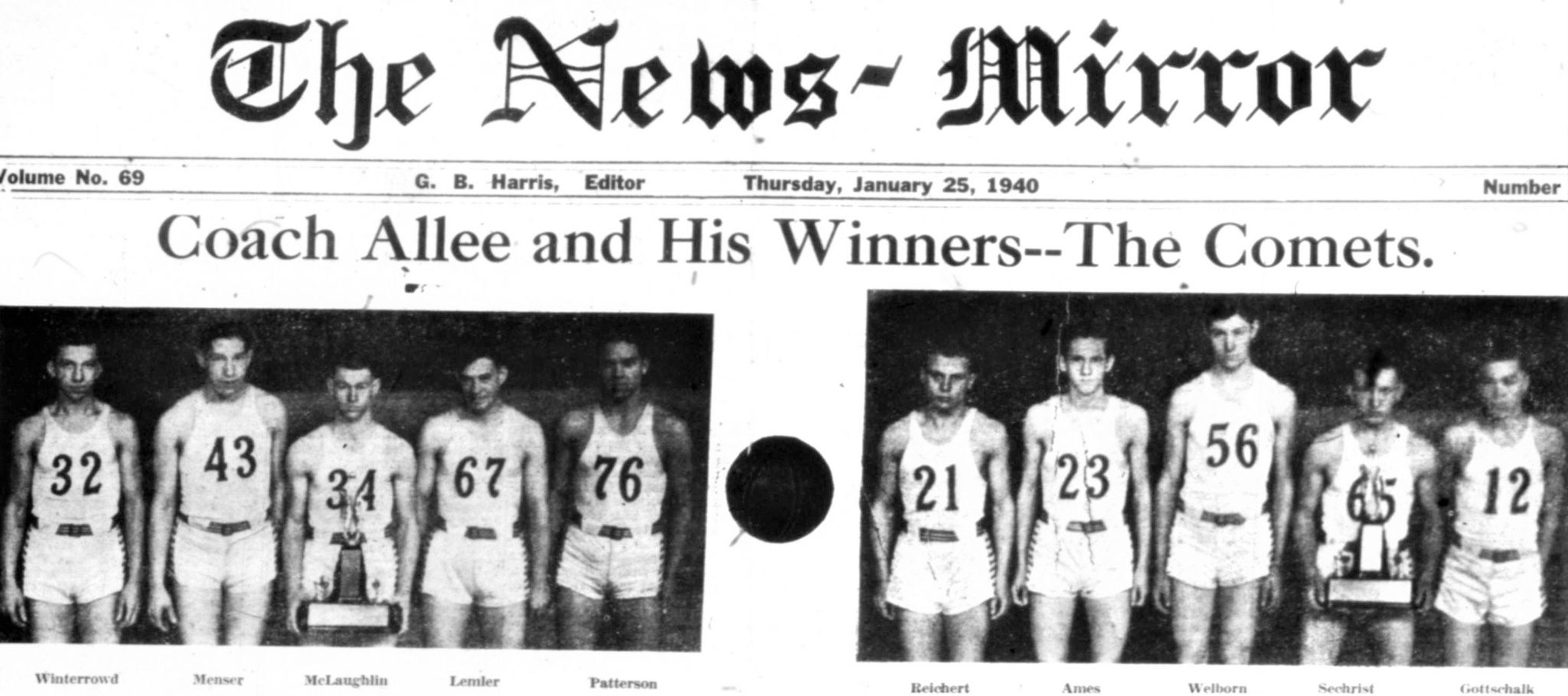
Coach Allee and His Winners– The Comets.
Bourbon High School’s Comets didn’t ever make it all the way to the State High School Basketball Championships, but were greatly excited by winning the county, or Sectional Championship a few times.
In 1940 with Coach, Kenneth Allee, they clinched their “well-earned right” to the county basketball championship according to the Plymouth Pilot newspaper article. Their win over Plymouth came in a 29 to 27 victory before a packed house. “Mr.Allee’s boys worked like the most exacting clock work and the game was a thriller from the first to the last…”
Though we have no pictures available, it was reported that the Comets won the Sectional tournament in 1943.
Seven years later the Comets, coached by Warren Seaborg, made a magnificent fourth quarter comeback over the North Judson Bluejays. Lead by Keith Stackhouse, who played the last quarter like “a driving demon”, the team converted what seemed a certain defeat to a decisive one-point victory.
Keith Stackhouse was honored that year by being chosen to play on the Indianapolis All-Star Team.
In 1962, the crowd went wild. Tears and cheers of joy broke out following the thrilling game when the Bourbon Comets downed the Bremen Lions 56-55 to cop the third sectional tournament championship in 20 years for Bourbon. The Plymouth Pilot News stated, “With meteoric brilliance Bourbon’s Comets, after trailing most of the way, soared from behind in the last seconds to flash past defending champion Bremen….” After the game, everyone in town, crowded into Berkey’s Grill to celebrate.
All three of these games were won by a very small margin after coming from behind.
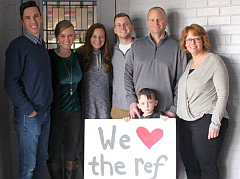
DAY MAKES INDIANA REFEREE HISTORY
(from the Plymouth Pilot-News, February 27, 2019)
PLYMOUTH – This year’s state girls 1A basketball game could have seen an Indiana basketball record for referee Ron Day of Plymouth. Although past records are incomplete, it appears that Day is the first referee in the history of Indiana to referee the 1A, 2A, 3A and 4A games for both boys’ and girls’ basketball at the state level.
Day began his referee career some 28 years ago when his daughter Katie was a newborn. “That’s when I realized how much diapers and formula cost,” he said.
Day said he was already a “sports junkie” and it seemed natural to get into the referee side of the game to make the extra money needed for his family. He credits his former high school athletic coach at Plymouth High School, Russ Teall, with encouraging him to get into the official’s side of sports. To become licensed in the state, applicants have to pass a written 100 question test. They then join one or more state associations in the sports they are interested in.
At the beginning of the season, each sport then holds pre-season meetings to go over any changes and offer season clinics. According to Day, there are now extra meetings held online along with videos showing a number of different aspects of refereeing. Day said he only referees basketball, but the majority work within multiple sports.
The average distance a referee covers in a game is between two and half to five miles. Day said he ramps up his workout routine after the annual Blueberry weekend held in Plymouth over Labor Day. In addition to the year-round treadmill time, he increases his jogging time. He now tries to limit his referee time to only one game a night, but that was not always the case.
“When I teamed up with my partner, Tim Filson,” he said, “we were calling some 80 games per season and we worked together for 18 years.”
Day said he has been mindful of how to manage his referee time with this business and his family. He owns his own contractor business and is able to schedule game time around projects.
“When the kids were little, they went to bed early and I could be out after their bedtime. When they were in high school, I limited the number of assignments so I could attend their activities,” he said. “Since varsity games are scheduled two years out, I had to check a lot of different schedules in order to balance family activities with my referee commitments.”
Referees usually begin by officiating lower level games such as those in elementary and junior high schools. He said there are any number of summer leagues where referees can gain valuable experience. Day says there is a huge need for more referees.
“For instance, there used to be only two referees assigned at the varsity level and now the requirement is three. The average age when a referee retires is 56. Now we are finding that there are retirements, but there are not enough younger men or women entering the profession to compensate.”
The system for assigning referees for state level tournaments is still highly competitive. To be eligible, applicants must have served as a referee for at least ten varsity games, attended eight association meetings, completed the rules and online meetings, and passed a tournament test by at least 90 percent. Then applicants are scored by every participating school in the state.
There is a need for 384 officials at sectionals, 144 at regionals, 24 for semi-state and 12 for the state finals. After refereeing the final state games, officials must go back to the sectional level and work their way back up to the state level over a four-year period.
Day says referees use the videos of games as a learning tool, especially since video is often taken at a different angle than the one an official was looking when a call was made. He said being heckled by the fans or coaches usually affects referees for the first few years, then it gets easier to tune loud fans out.
“Over the years you form relationships and tend to treat each other with respect,” he said. “Fans usually follow the attitude of the coach.” He added, “I’ve been fortunate to develop strong relationships with a number of coaches, athletic directors and players.”
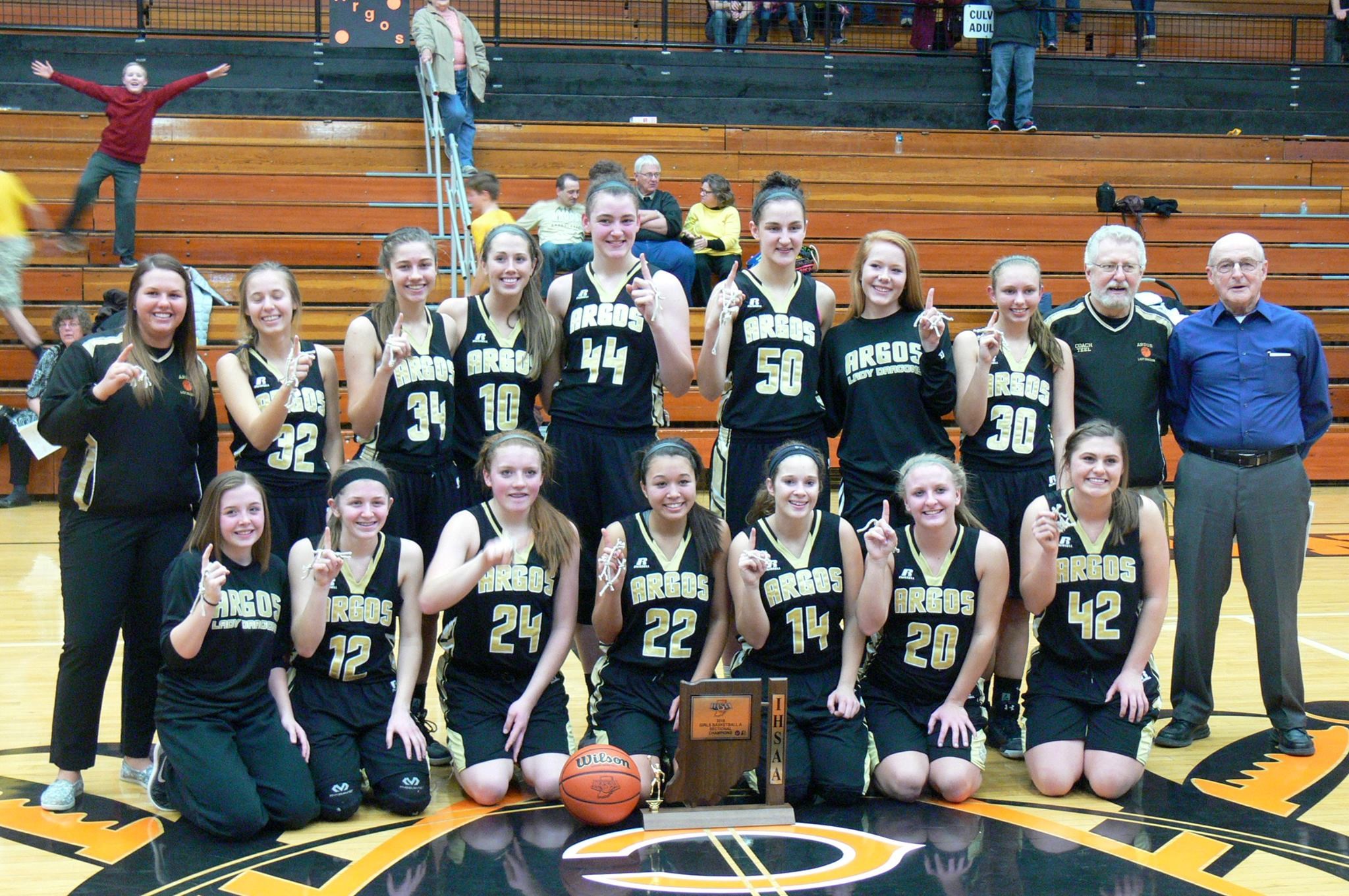
Girls Basketball Run Brings Back Memories for Tiny Argos
(Excerpted from an article by Kyle Neddenriep, Indianapolis Star, February 2, 2016)
ARGOS – For all but four of his 77 years, Gene Snyder has lived right here in this Marshall County community of 1,700 in Northern Indiana. The black and gold of Argos High School practically courses through his veins. Snyder graduated from here in 1956. He’s been the boys’ basketball coach, athletic director, girls’ basketball coach and soccer coach among his many titles.
When Snyder travels the state, or goes on vacation to Tennessee, he’ll often wear an Argos Dragons sweatshirt or hat. Occasionally, a stranger will approach him with a knowing smile. The conversation usually begins like this: “Argos – they had a good basketball team there, right?”
“They still know,” Snyder said. “I could be at a restaurant or a rest stop. People from Indiana still remember.”
There was a time, not all that long ago, when tiny Argos was poised to become the “next Milan” and follow in the footsteps of the most famous of the small school single-class champions of the 1954 boys’ basketball tournament.
Those stories have bubbled to the surface again this week as the Argos girls’ basketball team is knocking on the door of the state finals. With a win over Tri-Central on Saturday in the Class A semi-state at Crown Point, the sixth-ranked Dragons would clinch a spot in the state finals for the first time in program history.
But it is not the first time for Argos. In 1979, the boys’ team captured the state’s imagination with an incredible tournament run. Many of the same supporters were there 37 years later, last week in Caston when the girls won the regional. Before the regional semifinal game against Bethany Christian on Saturday, Argos senior Valerie Rospopo opened the locker room door and looked to her left. The sight of the bleachers packed with fans wearing black and gold sent a chill down her spine.
“The saying, ‘Everybody and their brother was there,’ applies,” Ropopo said. “It meant so much to us. I can’t even explain what it means to have that kind of support.”
Much has changed in Argos over four decades, like it has for many small Midwest communities. There were once three grocery stores, a clothing store, a dime store, a hardware story and other businesses ling Michigan Street that runs through downtown. Many of those businesses are gone now. But Argos has survived. And despite its status as the 32nd smallest basketball-playing school in the state, the support is arguably as strong as ever.
The team that put Argos on the Indiana basketball map began its journey long before March of 1979. In fact, some credit may be given to the school adding soccer all the way back in 1963. The basketball coach at the time, Ralph Powell, was interested in finding a sport to condition his team in the offseason. Argos, along with nearby Culver Military Academy, spearheaded what became an eight-school soccer conference starting in 1969.
Argos, under the umbrella of the Indiana Soccer Association, won the state tournament in 1973, ’76, and ’78. Snyder, who knew little about soccer, coached those teams.
“The boys taught me, more or less,” he said. “But by basketball season, they were in shape.”
The first week of soccer practice, Snyder didn’t even bring a ball. Mike Scheetz, a sophomore in 1978-79, remembers the 10-mile runs. One in the morning and one in the afternoon for a week.
“Soccer helped us with endurance,” Scheetz said. “Our success in basketball was really a continuation of what we did in soccer.”
The tournament run in 1979 didn’t come completely out of nowhere. Led by coach Phil Weybright, a former assistant under Snyder, the Dragons won the school’s first sectional title in 1978 at Plymouth and advanced to the regional final at Elkhart before losing to eventual state champion Elkhart Central.
Scheetz attended the 1978 state finals at Market Square Arena with his father, Dave, who starred at Plymouth and Butler in the 1950s.
“We had seats right behind the basket,” Scheetz said. “We were talking to the guy behind us and I told hem we’d be there next year – never dreaming that we actually would be.”
The 1978-79 season was a dream. Weybright started two seniors, Mark Malone and Bill O’Dell, and juniors Doug Jennings, Don O’Dell and Dave Calhoun. Eleven of the twelve players on the varsity roster had played on the state championship soccer team. Argos rolled to a 10-0 maker in the regular season with only LaVille (a 54-53 game in the championship of the Bi-County tournament) coming within 10 points. The Dragons beat Bremen, Plymouth and LaVille – for a third time – to win the sectional for a second consecutive year.
In the regional at Elkhart, Argos pounded Whitko 70-54 and knocked out the host and defending state champion Elkhart Central, 84-68, as it shot 70 percent from the field.
“Elkhart was extremely talented and big,” Sheetz said. “We just didn’t miss.”
That statewide media attention didn’t hit full-throttle, though, until the following week. Argos, with its 271-student enrollment, faced Fort Wayne Harding in the afternoon game of the semi-state at Fort Wayne. Argos was familiar with Harding star Jim Master, a junior who had transferred from Plymouth and would go on to win IndyStar Mr. Basketball in 1980.
Argos beat Harding, 66-64, as Malone hit two free throws in the final seconds. That set up a semi-state championship matchup that night against perennial power Marion. It was a thriller. Marion’s Larry Pettiford rallied the Giants in the fourth Quarter, hitting a jumper with eight seconds left to give Marion an 83-82 lead.
On the final possession, Bill O’Dell missed a short jumper but followed his shot and scored on the putback as time expired. Indiana governor Otis R. Bowen, a native of nearby Argos’ neighbor Bremen, was among those in attendance that night.
A radio call of the game’s final seconds is posted on YouTube. In it, the duo of Rick Derf and Corky Lingle of WTCA in Plymouth share a few moments of unrestrained joy as O’Dell’s shot falls.
“It’s good! It’s good!” Derf shouts. “Argos wins the semistate!”
“If there was instant replay, it would have been close,” Scheetz said of O’Dell’s buzzer-beater. “It happened so fast. It was really a fairy-tale ending. We weren’t scared of any team.”
If O’Dell’s shot had come in the state finals, it might have prolonged the existence of the single-class tournament. There’s no way to know for sure. Even at that time, there was talk of going to a class system, which eventually came to fruition in 1997 with the four-class model.
In the week leading up to the 1979 state finals, the Dragons were on spring break. Print and television reporters descended on Argos to chronicle the Cinderella story. Joining the Dragons in the final four were bluebloods Anderson, Muncie Central and Terre Haute South.
“There was a lot of talk about Milan that week,” said Snyder, who was athletic director in 1979. “The papers were writing about us and the TV stations were talking about us. It was unbelievable for a small community like this.”
Argos couldn’t recapture the magic against Anderson. The Dragons played from behind the entire way and struggled t stop standout Pat Skaggs, who finished with 24 points in a 74-64 Anderson win.
“It was our worst shooting game,” Sheetz said. “We were out of school that week and got out of rhythm. You can’t take anything away from Anderson. They were bigger and we couldn’t score like we had all year. Pat Skaggs just shot right over us.”
The Argos story didn’t end there. Jennings, the father of 2014 IndyStar Miss Basketball Whitney Jennings of Logansport returned for his senior year in 1979-80. Don O’Dell and Calhoun were also returning starters. If anything, the Dragons were probably more talented overall the following year. Argos was 21-0 in the regular season with only LaVille (a 54-50 regular season win) coming within 10 points.
“That team was probably better individually,” Snyder said. “We had more players. We did miss Bill O’Dell’s height though.”
Argos advanced to the regional final at Elkhart for a third consecutive season, this time facing Warsaw. A controversial foul call hurt Argos, and the Dragons missed some key free throws late in the game. Warsaw won, 52-51.
The following season, Argos snapped the state record of 61 consecutive regular season victories established by Madison from 1959-62. The Dragons completed a third unbeaten season in 1981 before losing to Whitko in the regional semifinal at Elkhart.
Argos’ regular season winning streak was finally snapped, at 76 games, the following season. The record, known around Argos as the “The Spirit of 76” remains the all-time mark.
“You still hear stories about it,” said Kelsey Hollabaugh, an Argos native and assistant girls’ coach. “My dad (Boyd Hollabaugh) was on the team that lost when the streak was broken. People still say, ‘Aren’t you that little small school?’ Yep, that’s us.”
It doesn’t take long to find ties that bind this year’s girls team to Argos’ past basketball success. Emily Calhoun, a junior, is the niece of the 1979 starting guard Dave Calhoun. Almost all of the players on the varsity roster had at least one parent graduate from Argos. Snyder and Hollabaugh, the two assistant coaches, span multiple generations.
A decade ago, the girls program won a sectional and regional for the first time.
The star of that 2006 team was Amberly O’Dell. Her dad, Don, started on the ’79 team. Hollabaugh was a freshman in 2005-06. O’Dell and Hollabaugh graduated as the program’s top two career scorers, respectively.
That team, like the ’79 group, came one game away from playing for a state title.
This one, led by 5’9” junior Courtney Dunlap (17.4 ppg, 6.1 rebounds, 5.4 assists) and 5’7” senior Rospopo (11.3 ppg) could knock the door down. The Dragons pulled off a dramatic 17 point second half comeback to beat South Central 79-47 in the sectional championship before pounding Bethany Christian and North White by 20 points apiece in the regional.
“I haven’t thought about state yet,” Dunlap said. “I try not to. Now that it’s here, I don’t know if it’s hit us yet that we’re playing in the semi-state.”
If not before, it’ll hit at 1 p.m. Saturday at Crown Point.
“To be one step away from the state finals is a dream come true for all of us,” said coach Gary Teel, 66, in his fourth year at Argos. “It’s something they can tell their daughters some day and show them the picture when they come back to school. Very few kids get to that point. It makes you feel good. That euphoria lasts a long time.”
No need to remind those in Argos. The “Spirit of 76” means more here than a number.
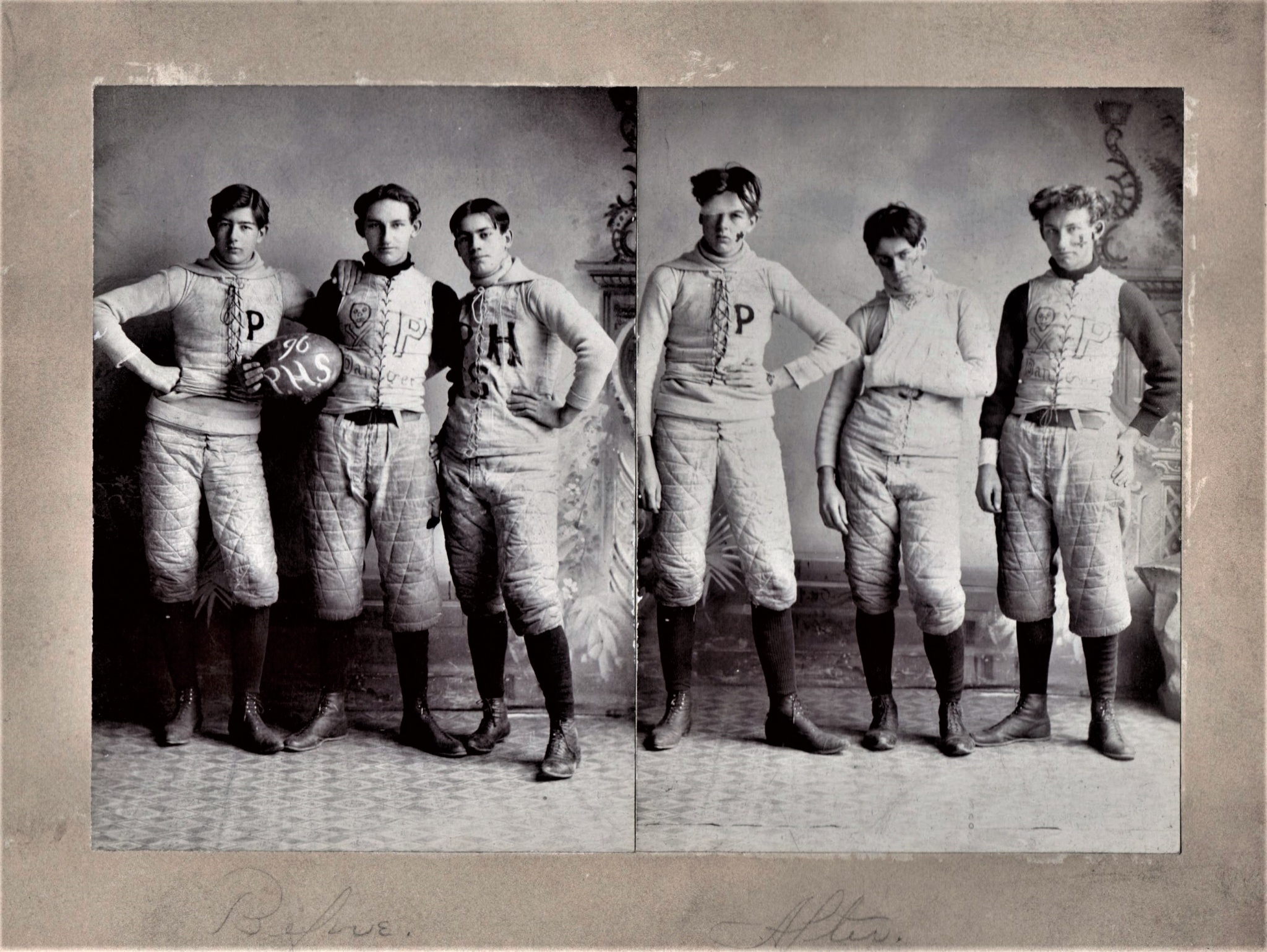
How Teddy Roosevelt Helped Save Football
At the turn of the 20th century, football was lethally brutal. No less than 45 football players died from 1900 – 1905, many from internal injuries, broken necks, concussions or broken backs. Newspaper editorials called on colleges and high schools to banish football outright. Some colleges cancelled their football programs while others switched to rugby.
In 1905 President Theodore Roosevelt summoned the head coaches and representatives of Harvard, Yale and Princeton to the White House. He urged them to curb excessive violence and set an example of fair play for the rest of the country. Locally, Plymouth football was placed under a ban by the school authorities when Plymouth citizens objected to the sport. It was not reinstated until 1924.
An intercollegiate conference approved sweeping changes for the 1906 season. The rule changes didn’t eliminate football’s dangers, but fatalities did decline. After a spike in fatalities in 1909, another round of reforms helped form the foundation of the modern sport.
High School Football at the Crossroads
(or the Decline of High School Football)
Participation in football programs peaked in 2008 at 1.11 million athletes, but after news reports correlating football with brain injuries become more common in 2009, participation in high school football began to decline. In fact, participation declined almost 5% to 1.06 million players by 2017. Although football is a long way from dead, there is no doubt that its peak has passed.
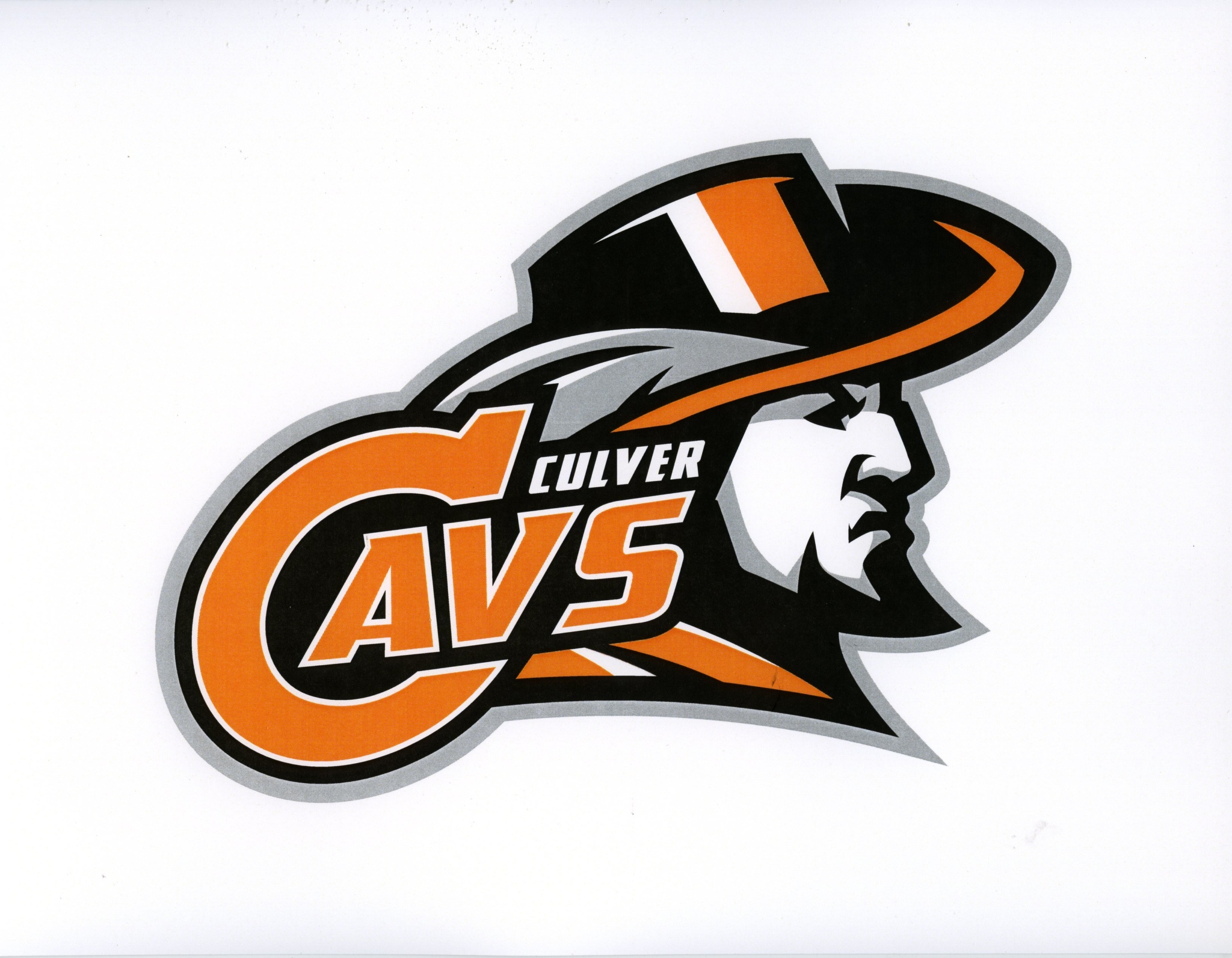
New Logo for Culver High School
In 2016 Culver Community School Corporation unveiled new school logos to improve marketing of the school corporation in light of the state’s move to school choice. The branding effort was coordinated by a group of volunteers, school staff members and parents working on the marketing component of the corporation’s strategic plan. They raised money for the project through a GoFundMe campaign that collected over $6,800.
Marketing team member Shelly Schrimsher says the campaign reached a wide variety of people. With the money raised, the team contracted with VIP Branding to design the logo family. The new brand contains a total of seven different logos the corporation can use for different situations. The logo they chose is an image of a shield backed by two swords. In front of the shield are the words “Culver Cavs.” The branding effort was a way for the corporation to control its image and potentially attract more families, at a time when per-student funding from the state has dropped.
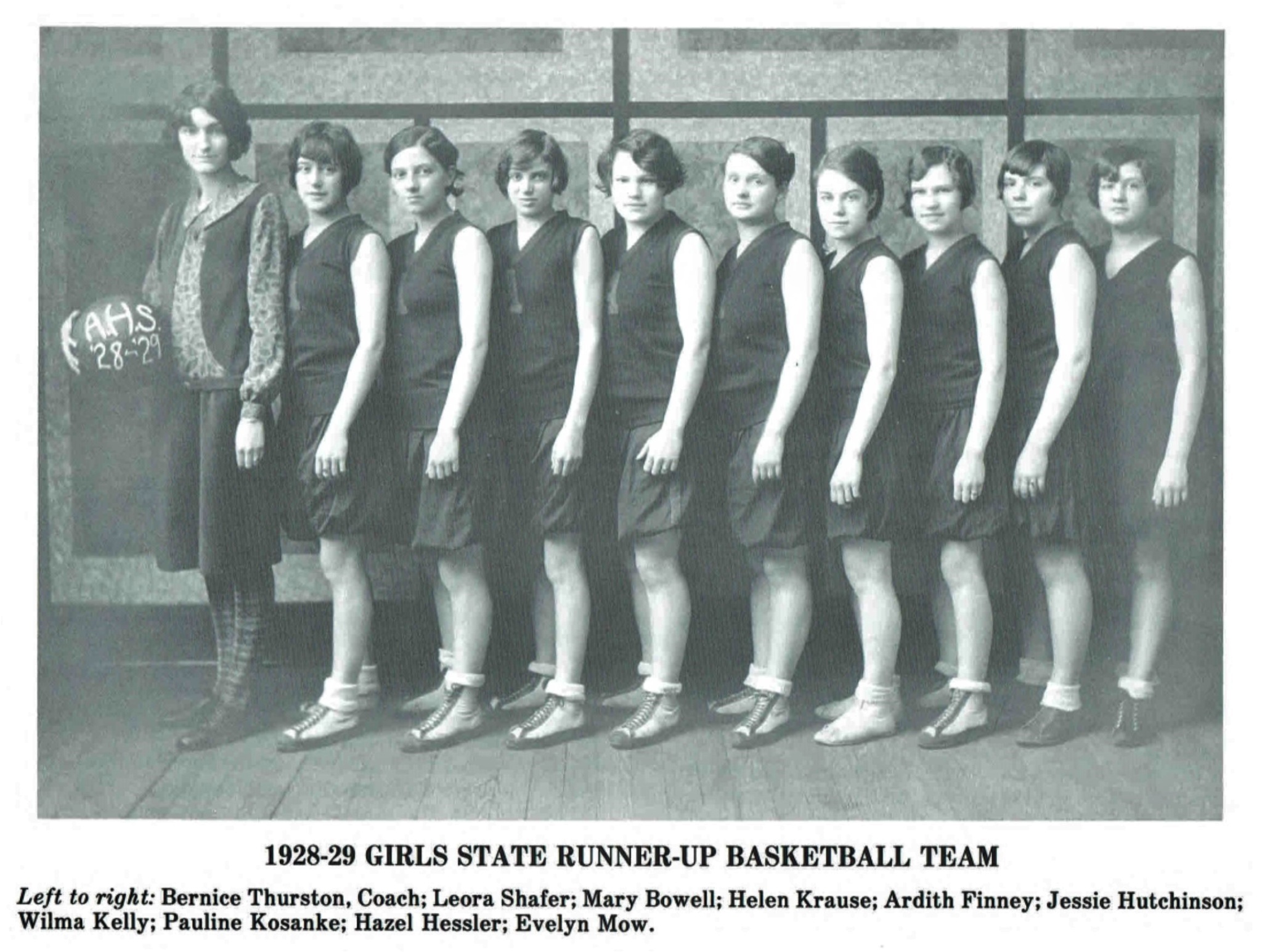
PRIDE OF ARGOS STILL OUR PRIDE
(Reprint from Argos Reflector, March 14, 1929)
Tho (sic) our girls had to bow to “Tall Sycamores of Wabash” they remain the “Pride of Argos.”
When our undefeated high school girls were met on the home hardwood last Wednesday evening by the equally unconquered sextet of the Wabash High School, each and all had that rare opportunity to sense “that stern joy which warriors feel in foemen worthy of their steel.” Wabash had issued a sweeping challenge and the Pride of Argos was the only team in Hoosierdom qualified even to answer the defy, and nothing that followed can dim the glory reflected by that outstanding fact.
Since the days when our Daniel Vorhees loomed aloft in the United States as the “Tall Sycamore of the Wabash” we have been convinced those smooth Whitebarks must grow especially tall down on the classic banks of the Wabash, but not until last Wednesday evening when that sextet of girls from Wabash-on-the-Wabash sallied forth on the floor of the local gym did our people have the remotest idea how tall even the sophomores grow down Wabash way. Those “tall sophomores of Wabash” loomed a full head above our girls on an average, and one or two of them made one or two of our girls look like dwarfs.
But when it came to playing basketball they had little on our girls save altitude but of that they made the most – getting the tip offs and playing quite literally over the heads of our “Pride.” A lot of air tight skirmishing and maneuvering featured the opening of the game, but Argos drew first blood when Mary bagged a pretty one. At the quarter our girls held the lead at a ratio of 8 to 5, but the half found them on the short end of a score of 9 to 14; while the finish found them with a total of 17 points while the visitors had piled up 30. It was, on the whole, one of the fastest and most exciting games ever witnessed in Argos, but our girls just could not quite reach their altitudinous antagonists.
Mary Bowell scored 11 points for the pride and glory of Argos and Pauline Kosanke copped six. Other players were Leora Shaffer and Wilma Kelly, centers; Jessie Hutchison, Helen Krouse and Ardeth Finney, guards. Miss Yost, agile forward, bagged 20 of the 30 points for the visitors. A record crowd of over 800 witnessed the game. There was a good delegation from Wabash and Plymouth, Culver, Bourbon, Bremen and other neighboring towns were well represented.
A goodly delegation of Argos fans accompanied the Argos girls to Wabash for the second and final tilt. As in the first game Wabash swung into the lead in the second quarter, the half ending 14-9; and the game ended 39 to 13 in favor of the tall damsels of Wabash. Argos fans who saw this game declare it was one of the hardest fought girls’ games they ever saw, being quite rough at times. It was felt referees did not do their best to curb the roughness. Three of our best players were thrown out on alleged fouls. Bowell made five points and Kosanke rolled up eight. Other players were Shaffer, Kelly, Finney, Hutchison, Krouse, Albright and Hessler.
That our little town has a team of high school girls who were the only ones in Hoosierdom qualified to take up the gauntlet thrown down by the tall Wabashers, and that they did take it up and “fought the good fight” to the last, against odds, will ever be the Pride of Argos.

Rampaging Russ Retires
25- YEAR track coaching career ends with roast
By Ida Chipman
SPECIAL TO THE PILOT NEWS
PLYMOUTH- Russ Teall, Plymouth High School’s track coach for the past 25 years, retired at the end of the 1998 season. He was honored by a “Roast the Coach” party at the conclusion of the track team’s annual banquet on June 4 in the high school cafeteria.
“Neither his teams nor I have ever seen Russ cry …. Until tonight,” Jeanette, his wife said.
Coach Teall, a Ball State graduate, has had an illustrious career as a track coach. In 1986 he was nominated by the IATCC as Indiana’s Coach of the Year. His Dual Meet Record stands at:
- 179 Wins; 76 Losses; three ties
- Five Sectional championships
- Five NLC Conference championships
- Three NLC Runner-up championships
- Two Goshen Relay titles
- Three Goshen Relay runner-up titles
Teall is most proud of the fact that 47 of his athletes competed at the college level, 17 of them in Division I schools. Two were Collegiate All-Americans.
These things were not what his former athletes returned to talk about.
Pete Bieghler,’88, spoke of grueling practices and “meetings of the mind,” which is a kinder, gentler way of saying “chewing out of the butt.”
Brian Cavagnini,’78-’82, who flew in from Ohio, told of how the team had watched “Chariots of Fire,” until they were sick of it, but how the movie and the music became part of their training.
Carlos Fuentes,’83, who won a grueling race and set a school record with only one shoe, recalled how coach Teall, in preparation for a special meet, told the team that “no one was going home until everyone throws up.”
Carlos and his teammate rushed out and ate three quarter-pounders so they’d have the proper “equipment.” Sure enough, at the end of several sprints, Carlos was heaving on the sidelines.
“Yeah! That’s it!” Said the coach. “Now go do two more.”
Other comments were more serious.
“You made me know that I can do more…take that extra step…more than I ever thought I could.”
The men agreed that coach Teall was tough. That he was positive, enthusiastic and that he was the best coach they ever had.
Kent Naylor, ’73-’75, “was so gung-ho, he made our lives a living hell. We missed Coach Shockney like crazy.”
He preached, “Never quit, never give up.”
“If you run track, expect to be proud. You wear the uniform not just to impress the girls.”
Teall used “Warrior” speeches, “Race Car” speeches, “Patton” speeches…. All kinds of motivational tools. Roy Benge, assistant athletic director, said that Teall expected his boys to be competitive in everything.
“Even,” he said, “in the rest room.”
He wanted 150 percent.
One of the highlights of the evening was retired track coach, Russ’ high school mentor, Dale Kelly from Concord.
“He may have told you how fast he ran the mile, but I,” coach Kelly said, “had the stopwatch.”
Kelly told how Russ was a “late bloomer”. He sat the bench in freshman and sophomore basketball. With a new coach and a great track record, he finally made the varsity basket all team.
“He is,” Kelly added, “a coach’s coach.”
After his old coach’s remarks, Teall told the crowd how much Dale Kelly had meant in his life. “I had an alcoholic step-father,” he said, “and I went through some tough times in high school. I have never told anyone this before.”
“Dale Kelly was a father-figure to me. I will always be grateful.”
A Special gift from this year’s graduating seniors on the team was a hooded sweatshirt with 1973-1998 stitched on the back. The Plymouth Athletic Department, represented by Benge, presented Teall with an engraved clock. An embroidered jacket from Plymouth Booster Club was presented by Sam Baker.
Among the past members of Teall’s track team attending were Phil Bockman, Kent Naylor, Brian Cavagnini, Carlos Fuentes, Charlie Fox, Mitch Ripley, Tom Finkbiener, Pete Bieghler and Adam Hamilton. Also present were former assistant coach Ron Harnish, Russ’ former high school coach at Concord High School, Roy Benge, Russ’ co-head coach for 17 years and Master of Ceremonies and new head track coach, John Barron.
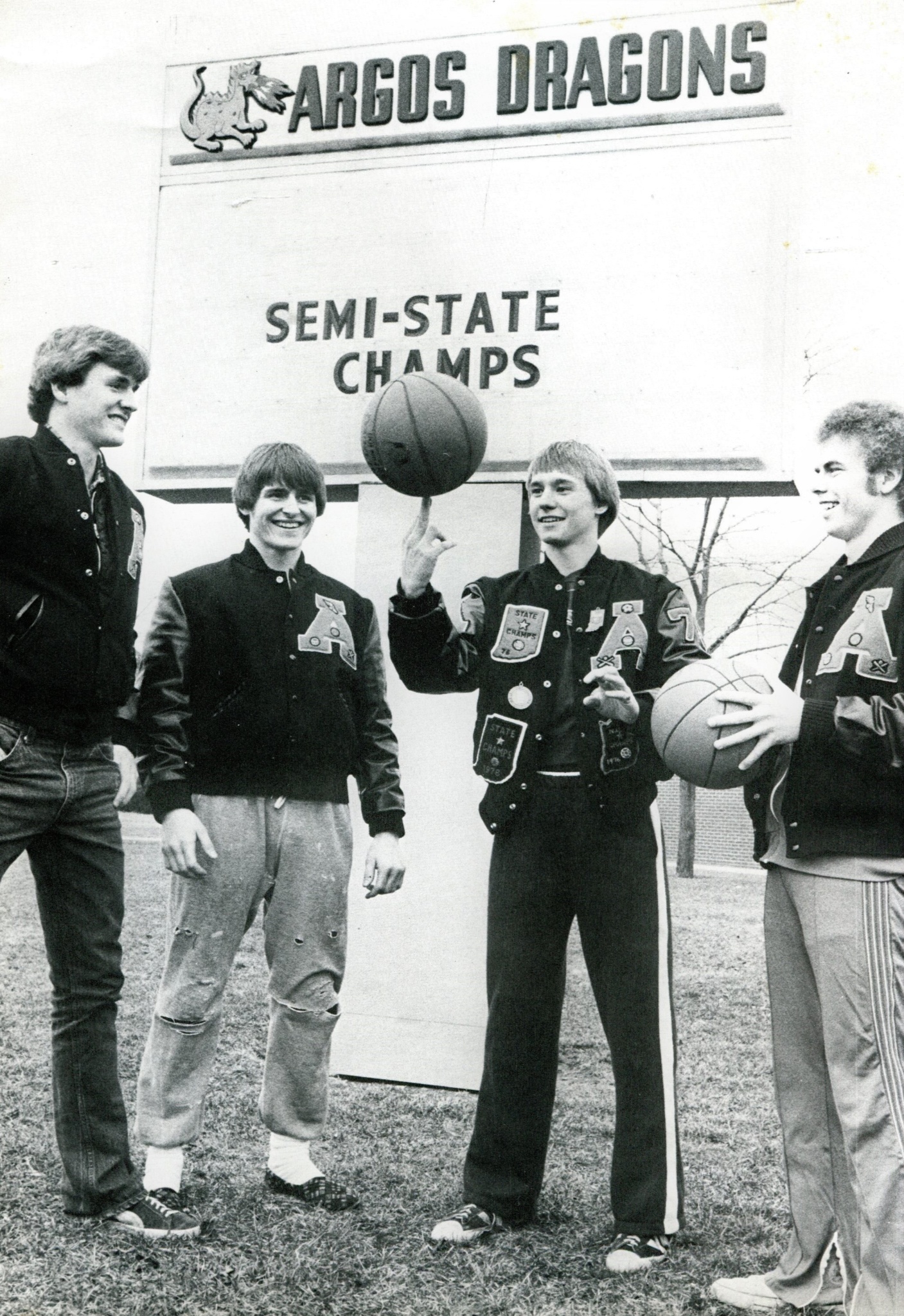
Smallish Argos Giant in Semistate
By Jay Margolis
Staff Writer
The Journal Gazette Sun., March 18, 1979
Bill O’Dell followed up on his missed jump shot and tipped the ball through the basket at the buzzer to give Argos an incredible 84-83 victory over Marion in the championship game of the Fort Wayne Semistate Tournament Saturday night before 7,798 fans.
Argos, the smallest school in the tournament after the regionals last week, will pursue the Milan “small school” dream of a state championship on the silver anniversary of the Bobby Plump shot next Saturday at Market Square Arena. Argos, the smallest school to reach the finals since 1966, will take on Anderson in the first round of the state tourney with Terre Haute South and Muncie Central, the defending state champ, meeting in a rematch of last year’s state title game.
“I can’t believe we’re going to state,” Argos coach Phil Weybright said. “One in a million.” O’Dell explained the decisive odd point and how it came about.
“We were running our 1-4 offense. I wasn’t supposed to get the ball up there (foul line). I was supposed to get it down low. We had to get it in the hole. Time was running out,” he said.
“I just got the ball. All I was thinking about was going to the hoop. 42 (Aric Keys) was supposedly slower than me,” O’Dell said of his intention of driving. “He had help on both sides. I just went up for the jump shot. I saw the ball roll around the rim. I knew if it didn’t fall, we were done this year. I didn’t want to be done this year.”
He crashed the boards, the ball hanging on the rim long enough for him to come down from the foul line to the basket. The 6-foot-2 senior went up and got the ball as it came off. “It was enough that it wasn’t offensive goaltending,” he smiled. O’Dell scored 12 of his 22 points in the fourth quarter as Argos and Marion went at each other’s throat basket for basket. O’Dell drew Morris Tyson’s fifth foul with 3:33 to play and his two free throws put the Dragons ahead 74-69.
Larry Pettiford and Keys scored to bring the Giants within one and Jeff Todd’s 12-footer from the left baseline gave Marion the lead with 2:28 to play, 75-74. With Tyson out of the middle, Argos went to O’Dell, who was able to maneuver around and through Keys.
“That definitely helped us,” Weybright said. “We kept going to Bill. To win that without Bill O’Dell in the third quarter is unbelievable.” O’Dell had sat out the last seven minutes of the period after picking up his fourth foul.
Two free throws put Argos up, Pettiford’s jumper tipped the lead back to Marion, two more free throws by O’Dell seesawed the edge toward Argos. It went back and forth through the final minute with Jeff Wharton scoring for Marion, O’Dell for Argos, Pettiford for Marion, Doug Jennings for Argos and the Dragons led, 82-81, with 26 seconds left.
Marion called time with 17 seconds, worked the ball down low to Pettiford on a pass from Todd and he dumped in a short jumper. “You’ve got to take the shot when you get it,” Marion Coach Larry Liddle said. “Eight seconds is a long time. It’s one second too long.”
Argos called time with eight seconds left. The plan was to go to O’Dell with Jennings as an alternate. But O’Dell got the job done. Argos’ hot hand forged a first-half lead of 42-34 with Jennings and O’Dell each getting 10 points. The Dragons were 16-of-27 from the field for the half, and 10-for-10 from the foul line in the second period while Marin was 6-of-13, including two two-shot opportunities. Argos outrebounded Marion 13-12, in the first half.
Marion didn’t warm up any in the third quarter, making only 11-of-27, but the Giants did hit the boards, pulling off 16 rebounds to only 4 for Argos and cut their deficit to 63-59 by the end of the period. Pettiford had 9 points and Todd 8 in the rally. “We didn’t miss many the last quarter. They didn’t miss many the last quarter,” Liddle said. “They made the last one.”
As Argos had in the afternoon against Harding, it won the game at the line making 22-of-28 to 9-of-17 for Marion. The Dragons connected on 31-of-52 field-goal attempts for the game for 59 percent while Marion made 37-of-61 for 60 percent. Marion bowed out at 20-7. Jennings paced the Argos attack with 24 points and Mark Malone had 12.
The Dragons go to Market Square Arena with a 28-0 mark, the first team in four years to take a perfect record to state. Loogootee was unbeaten that year but forfeited a game to Shoals. East Chicago Washington was undefeated in 1971 and went on to win the state championship.
Argos, with 271 students, also became the smallest school in the “Final Four” since Cloverdale in 1966. The Clovers then had 225 pupils. The Dragons may be few, but they are smart and keeping their wits in the crises of the semistate was the determining factor in their emergence.
“They never panicked,” Weybright said. “They never thought about what would happen if they missed. They just kept on going.” To Market Square Arena.
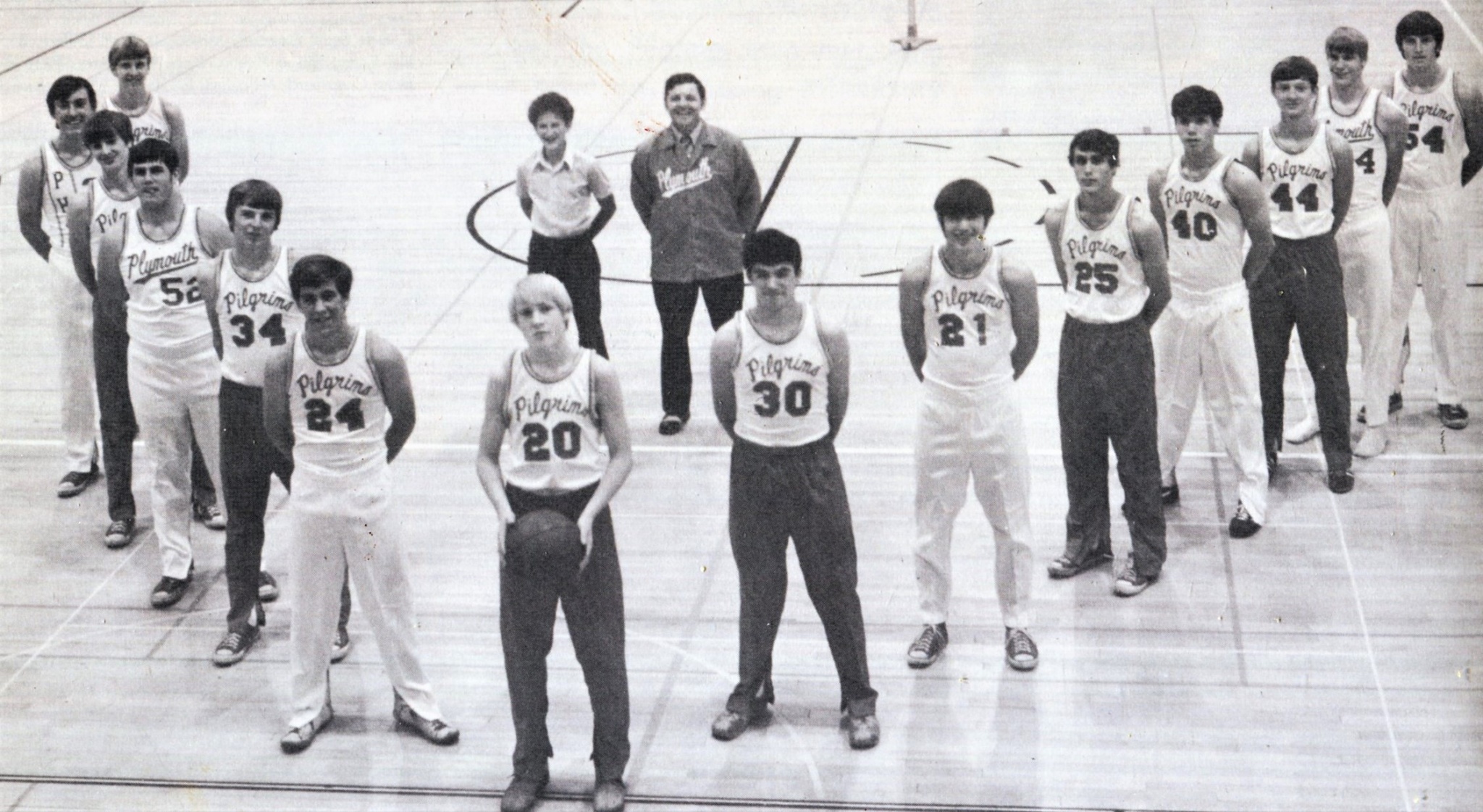
The Rock, Home of Plymouth Basketball Since 1976
The Plymouth Pilgrims basketball team had called “The Rock” its home since the fall of 1976; 201 seniors have played for the Pilgrims during that time. These seniors have been coached by four different head coaches during those 43 years with 31 of those years lead by Indiana Basketball Hall of Fame Coach Jack Edison.
The previous four seasons before calling The Rock their home, the Pilgrims played most of their “home games” at Triton High School. The decision to abandon Centennial Gym was made by Plymouth administration. Centennial Gym, which had been the home of the Pilgrims since 1936, was outdated. The Pilgrims needed a new varsity gym. The Class of 1976 played all four of their high school years traveling to reach their home court destination. The 1976 Pilgrims seniors included Jerry Cook, Mike Crawford, Brent Dipert, Dave Faulstich, Tom Jung, Steve Kring and Greg Renz.
An addition to the existing Plymouth High School was finally completed in the summer of 1976. A new auditorium along with a new varsity gym were the main components of this addition.
Over the last 43 years, the Pilgrims have played a total of 518 home games at The Rock, winning 391 of those games – winning percentage of just over 75 percent. They have hosted 39 IHSAA Sectionals during that time. The Pilgrims have had a record of 73-22 in IHSAA tournament games played at The Rock, a winning percentage of 77 percent.
The very first scheduled varsity boys basketball game was played against the Goshen Redskins on Friday, November 26, 1976. The Pilgrims defeated the Redskins that night 57-54 in front of more than 3,000 fans, according to the November 27, 1976 edition of the Pilot News writer Kevin Woodward.
Pete Buchanan scored the very first basket of the game as the Pilgrims built an early 6-0 lead over Goshen. The Pilgrims lead the Redskins 12-10 at the end of the first eight minutes of play. The lead changed hands four times during a back-and-forth second quarter and ended in a tie at 22.
Even though the score was tied at half-time, the Pilgrims had been whistled for several more fouls than what had been whistled against Goshen. In fact, the Pilgrims did not shoot their first free throw of the game until there were only 26 seconds left in the third quarter. By that time, Goshen had hit 20-24 free throws, and lead the Pilgrims 41-40 heading into the final quarter.
Steve Keiser, John Wendel and Bob Albertson all had limited minutes during the first three quarters because of foul problems. All three ended up fouling out of the contest before the final horn had sounded.
The Pilgrims came out strong in the fourth quarter. John Beeker hit a pair of free tosses and then scored on a hook shot. John Wendel hit a jumper and the Pilgrims led 46-41.
Goshen hit a bucket narrowing the Pilgrims lead to 46-43 with under five minutes remaining. Albertson re-entered the contest at the four minute mark and made an immediate impact. He hit a turn-around jumper at 3:06 and the Pilgrims built their lead back up to 48-43.
At the 2:40 mark of the final quarter, Keiser was called for a charging foul, his fifth. A moment later, Wendel also picked up on his fifth foul, also on a charge call. Goshen then went on a 5-0 run to knot the score 48-48. A pair of buckets by both teams brought the score to 52-52 with one minute remaining. The Pilgrims called a time out to set up a final play. They worked the ball inside to Albertson who scored and was fouled. He hit the free throw and completed the three-point play and the Pilgrims led 55-52.
On the ensuing possession, Albertson was whistled for his fifth and final foul. Goshen missed on the front end of the one-and-one. Buchanan was fouled on the rebound and hit one of the two free throws, pushing the Pilgrims’ lead to 56-52 with 22 seconds remaining. Beeker also added a late free throw pushing the lead to 57-52. Goshen hit a shot at the buzzer to make the final 57-54.
